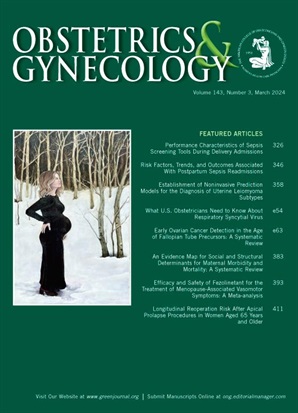磨牙妊娠的病因、自然病史和处理的最新进展。
IF 4.7
2区 医学
Q1 OBSTETRICS & GYNECOLOGY
引用次数: 0
摘要
磨牙妊娠是一种罕见的生殖异常,全球发生率为1:10 00-1,500。它是由异常受精引起的,可能与医学并发症或进展为磨牙后妊娠滋养细胞瘤有关。磨牙妊娠表现为完全葡萄胎和部分葡萄胎两种不同的实体,它们在临床、遗传和预后方面有所不同。产妇年龄和磨牙妊娠史是发生磨牙妊娠的主要危险因素。超声早期诊断磨牙妊娠与医学并发症的减少有关,但与磨牙妊娠后滋养细胞瘤的减少无关。在诊断推测为磨牙妊娠后,患者应转诊给有经验的专家,或到参考中心进行子宫引流和磨牙后随访,这有助于早期诊断妊娠滋养细胞瘤。每周测定人绒毛膜促性腺激素对于确认缓解和确定需要进一步治疗的妊娠滋养细胞瘤病例至关重要。为了保持该肿瘤标志物的可靠性,在磨牙后随访时建议采用激素避孕。在部分葡萄胎和完全葡萄胎缓解后,磨牙后随访应分别延长1个月和3 - 6个月。磨牙妊娠后的生殖结果与一般人群相当,但复发磨牙妊娠的发生率较高,影响1.0-2.0%的后续妊娠。磨牙妊娠的巨大社会心理影响需要多学科方法,以尽量减少这种疾病对心理健康的影响。本文章由计算机程序翻译,如有差异,请以英文原文为准。
Etiology, Natural History, and Management of Recent Advances in Molar Pregnancy.
Molar pregnancy is a rare reproductive anomaly that globally affects 1:1,000-1,500 pregnancies. It is caused by aberrant fertilization and can be associated with medical complications or progress to postmolar gestational trophoblastic neoplasia. Molar pregnancy presents with two distinct entities, complete and partial hydatidiform mole, which differ in their clinical, genetic, and prognostic aspects. Maternal age and history of molar pregnancy are the main risk factors for the occurrence of molar pregnancy. Early diagnosis of molar pregnancy by ultrasonography is associated with a decrease in medical complications but not decreased postmolar gestational trophoblastic neoplasia. After the diagnosis of a presumed molar pregnancy, patients should be referred to an expert with experience taking care of molar pregnancy or to a reference center for uterine evacuation and postmolar follow-up, which facilitates early diagnosis of gestational trophoblastic neoplasia. Weekly human chorionic gonadotropin measurement is essential to confirm remission and to identify cases of gestational trophoblastic neoplasia that will require further treatment. To maintain the reliability of this tumor marker, hormonal contraception is indicated during postmolar follow-up. The postmolar follow-up should extend for 1 month and from 3 to 6 months after remission in cases of partial and complete hydatidiform mole, respectively. The reproductive outcomes after molar pregnancy are comparable with those of the general population, except for the higher occurrence of recurrent molar pregnancy, affecting 1.0-2.0% of subsequent pregnancies. The considerable psychosocial repercussions of molar pregnancy require a multidisciplinary approach to minimize the repercussions of this disease on mental health.
求助全文
通过发布文献求助,成功后即可免费获取论文全文。
去求助
来源期刊

Obstetrics and gynecology
医学-妇产科学
CiteScore
11.10
自引率
4.20%
发文量
867
审稿时长
1 months
期刊介绍:
"Obstetrics & Gynecology," affectionately known as "The Green Journal," is the official publication of the American College of Obstetricians and Gynecologists (ACOG). Since its inception in 1953, the journal has been dedicated to advancing the clinical practice of obstetrics and gynecology, as well as related fields. The journal's mission is to promote excellence in these areas by publishing a diverse range of articles that cover translational and clinical topics.
"Obstetrics & Gynecology" provides a platform for the dissemination of evidence-based research, clinical guidelines, and expert opinions that are essential for the continuous improvement of women's health care. The journal's content is designed to inform and educate obstetricians, gynecologists, and other healthcare professionals, ensuring that they stay abreast of the latest developments and best practices in their field.
 求助内容:
求助内容: 应助结果提醒方式:
应助结果提醒方式:


